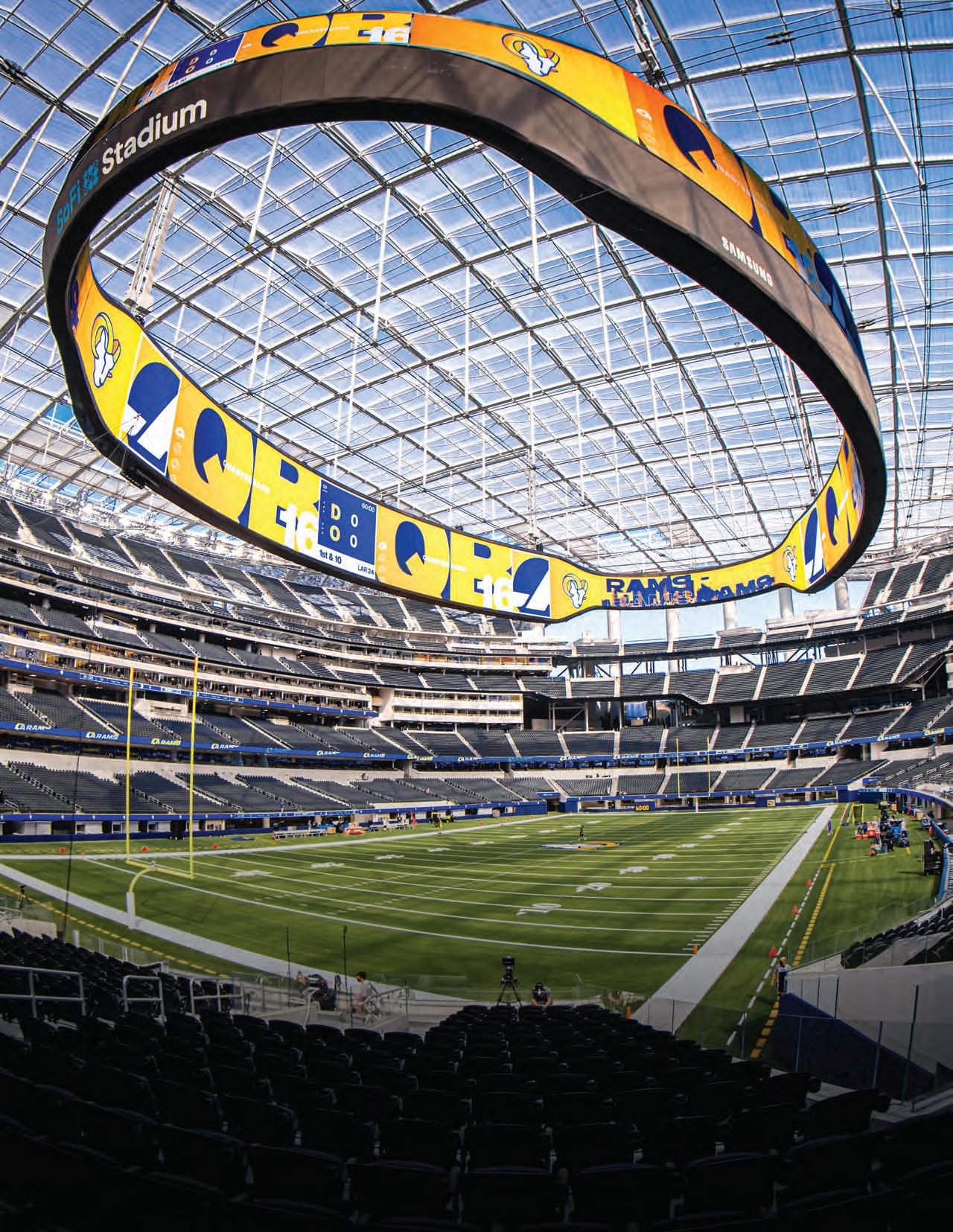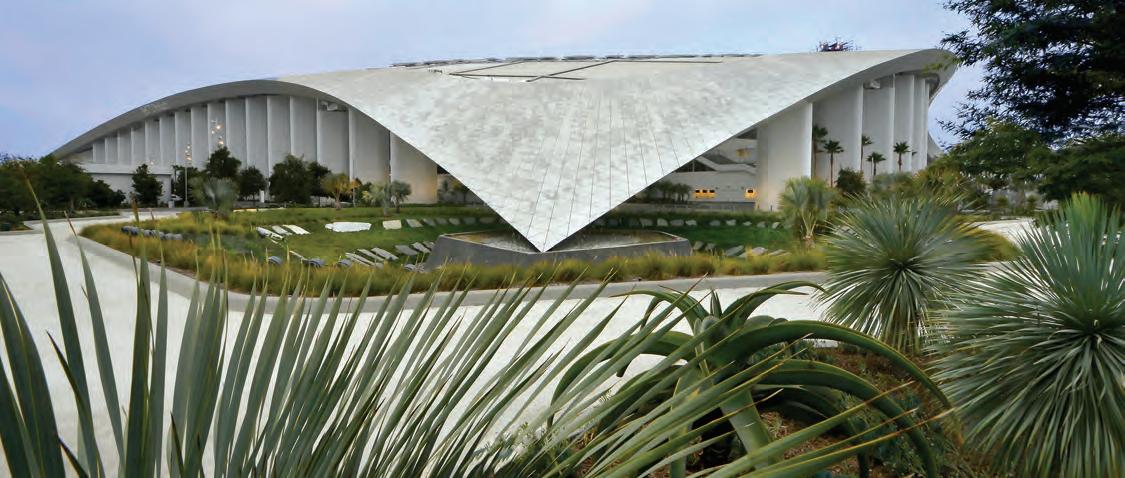
6 minute read
CONVERGED INNOVATION: SOFI STADIUM NETWORKS BREAK NEW GROUND
BY PAUL KAPUSTKA
WHEN YOU SPEND MORE THAN $5 BILLION BUILDING A REVOLUTIONARY-LOOKING NEW SPORTS AND ENTERTAINMENT VENUE, IT’S A GOOD BET THAT THE TECHNOLOGY INSIDE IS THE BEST THAT CAN BE FOUND.
Advertisement

FACING PAGE: THE OVAL, DUAL-SIDED VIDEOBOARD; THIS PAGE: THE WATER FEATURE OUTSIDE SOFI STADIUM.
CREDIT ALL PHOTOS: SOFI STADIUM/LOS ANGELES RAMS (EXCEPT WHERE NOTED)
What’s truly innovative at the new SoFi Stadium in Los Angeles is not just the quality and functionality of the technology’s pieces and parts, but also the venue’s embrace of a converged network design, where all network-attached devices connect to a single Cisco Catalyst-based network.
Led by Skarpi Hedinsson, chief technology officer, SoFi Stadium and Hollywood Park, and master technology integrator AmpThink, the networking and compute environment deployed inside the building (as well as in Hollywood Park’s neighboring retail, commercial and residential area) is unlike most large venues, where different systems typically exist in their own silos, often with their own separate and different network.
Instead, the SoFi Stadium network brings all building functionality – including the wireless networks (among the largest built anywhere), the server compute platform, the telephone system, the IPTV network, the indoor and outdoor digital signage (including the massive oval dual-sided 4K main videoboard), the television broadcast systems, and the building management systems – into one converged platform, with a single vendor/single format structure.
“What we delivered is a scalable platform that simplifies Day 2 operations on Day 1,” said AmpThink president Bill Anderson.
Over the coming months, Stadium Tech Report plans to do deep technical dives on each segment of the stadium’s different technology deployments. Consider this story a sort of “executive summary” that will attempt to at the very least introduce all the technology elements that are part of the stunning new venue, which hosted its first NFL games for both stadium tenants, the Los Angeles Rams and the Los Angeles Chargers, in early September.

A FIELD-LEVEL VIEW OF THE VIDEOBOARD AND THE STADIUM.
Converged network a revolution for stadiums
If the stunning architecture of SoFi Stadium and its innovative elements like the oval, dual-sided videoboard represent the realization of Rams owner and Hollywood Park developer Stan Kroenke’s “art of the possible,” then the converged network and its interlocking technologies perhaps represent “the art of the practical,” at a scale somewhat unprecedented inside a large public venue.
If you poke your head inside older sports venues, you are most likely to see separate networks and operation centers for many of the different systems – wireless, wired networks, broadcast, and building operations. Historically the case has been made that those who know those systems best are responsible for building their operations – but the silo approach often brings headaches to those in charge of overall operations for the venue as a whole, as they deal with the proliferation of different systems to operate and manage.
AmpThink, which has deployed networks in more than 70 venues across the country, pioneered the idea of a single, converged stadium network when it built the prototype at the 14,000-seat Dickies Arena last year. But the size and scope of the converged network project at SoFi Stadium – which will hold 70,000 fans for NFL games and up to 100,000 for special events like the Super Bowl – was much larger. Still, according to AmpThink’s Anderson, the planned outcome was the same: to deliver the best outcome for the customer.

TEAMS ON THE FIELD AT THE CHARGERS’ FIRST HOME GAME
CREDIT: TY NOWELL/LOS ANGELES CHARGERS

THE STADIUM DURING CONSTRUCTION

AN OUTSIDE STADIUM VIEW
“It all works together, because it’s designed to work together,” said Anderson. “Instead of fighting to see if one switch works with another, you can focus on the business.
Even the live video production system, usually a completely separate entity, is run on a connected Cisco Nexus switched environment. Every telecommunications closet or cabinet is directly connected via fiber to the campus core. Accordingto AmpThink, all the telecom rooms have edge switches that use 25 Gbps optics and a minimum of two connections per closet/cabinet to provide an aggregate of 50 Gbps of campus interconnectivity.
The blanket of Wi-Fi and cellular coverage
On the Wi-Fi side, the SoFi Stadium network is the biggest AmpThink has built in a stadium, with approximately 2,400 APs inside the venue and another 300 in the surrounding Hollywood Park area. For the full Wi-Fi 6 Cisco deployment, AmpThink used an under- seat deployment in the main bowl.
Before expanding to include full stadium technology integration, AmpThink made its name in successful big-venue Wi-Fi network design and deployment, with networks built most recently at Mercedes-Benz Stadium in Atlanta, and last year at Ohio State and Oklahoma University, the first two large-stadium networks to move exclusively to the new Wi-Fi 6 standard.
In a commitment to offering the best possible connectivityto consumer devices no matter which network they use, the Wi-Fi and cellular distributed antenna system (DAS) at SoFi Stadium were both designed to each provide 100 percent venue coverage. The DAS, designed and deployed by DAS Group Professionals using gear from JMA Wireless, is the largest ever deployed. According to Hedinsson, the network has 2,400 antennas and 3,200 remotes, and is capable of covering all licensed spectrum bands between 600 MHz to 6 GHz. As cellular carriers move toward the 5G future, the DAS is capable of supporting all the low- and mid-band spectrum currently planned for use. According to Hedinsson, there will also be millimeter-wave 5G services in the stadium, from a carrier to be named later. The stadium networks are supported by 50 Gbps backbone links.

FANS IN THE LOWER BOWL WILL BE ABLE TO SEE VIDEO ON THE INSIDE OF THE OVAL BOARD.
Bringing data center strategies to the stadium
While hyper-convergence of server use is common in the data center space, that has traditionally not been the case in sports and entertainment venue operations. But the eventual compute network built for SoFi Stadium’s operations even surprised AmpThink’s Anderson, whose company originally estimated a compute environment with perhaps 20 to 30 virtual machines.
As it stands now, Anderson said the compute environment has almost 100 VMs, which host applications for all the network operations as well as varied building management needs like power, light, HVAC, security, and even specialized systems like irrigation and seismic monitoring. Instead of a mix of servers running siloed applications on separate physical machines with different operating systems, the SoFi Stadium compute environment is a unified platform and includes a seamless integration into Google Cloud, allowing it to be easily scaled to meet current and future needs.
A digital stadium with displays big and small
Any discussion of digital displays at SoFi Stadium has to start with the main videoboard, a one-of-a-kind design of a 120-foot long oval that circles the playing field, with dual-sided 4K screens, some 40 feet in height. (Please see our detailed profile of the main videoboard in our recent Venue Display Report.)
The digital display footprint goes far beyond the main screen, with some 2,600 other smaller boards deployed throughout the venue and in Hollywood Park. According to Hedinsson, the ability of the Cisco Vision display management system is a key part of the “digital stadium” design, especially when you consider that the venue has two main tenants, each with their own branding and look and feel.
“Being digital means we can switch over the branding [by changing displays] instead of physically having to move signs,” said Hedinsson. “That’s why we have Cisco Vision. We have digital ‘playbooks’ for the different scenarios, and we can just push them out as needed.” –STR–


